Re: Pegleg's Black Gold Nuggets
Pegleg Mine -- 1884
Tom Cover was a systematic prospector. Determined to find
Pegleg Smith's lost mine, he collected all the Pegleg stories, rumors,
hints—every scrap of information or hearsay he could—and, evaluating
them, drew up a list of clues to guide his search. Some of his conclusions
were printed in a Riverside, California, newspaper in 1884, soon
after Cover's disappearance on his final trek into Pegleg country—
the Borrego Badlands of the Colorado Desert. Henry W. Splitter recently
discovered these newspaper accounts and incorporates them into this
story of Tom Cover's persistent but fruitless search.
IN 1884, Tom Cover, a prominent
citizen of Riverside, California,
went to the Colorado Desert in
search of the Lost Pegleg Mine. He
never returned.
In itself, this isn't an unusual tale.
Many men, lured by visions of vast
wealth, have sought Pegleg Smith's
black gold nuggets, and many have
lost their lives in the search. But
Thomas Cover wasn't an ordinary
prospector.
Cover had come to Los Angeles in
1867 from Alder Gulch, Montana,
where he had been one of the first
discoverers of gold in that state. With
a fortune of $75,000, he traveled west,
finally settling in Riverside where he
remained the rest of his life. He is
reputed to have been one of the first
settlers in that community and to have
helped introduce the Washington or
Riverside navel orange to citrus ranchers
there.
The role of city founder and orange
rancher did not entirely satisfy Cover.
Indeed, he often declared that the main
reason he had come to Southern California
was to find the Lost Pegleg
Mine. For 17 years he carried on this
quest, and at the time of his disappearance
was the Southland's dean of
lost mine prospectors.
During this entire period Cover had
been collecting all available Pegleg
stories, rumors and hints to help guide
his search. Some of these were printed
in a Riverside paper in 1884 subsequent
to his disappearance. Eventually
forgotten, they have only recently
again come to light. Recorded here
is Cover's story of the original finding
of the mine enroute from Yuma to Los
Angeles.
"On the evening of the third day
out from the Colorado," he relates,
"they (Pegleg Smith and his companions)
had camped, when one of their
number climbed a little hill or butte 50
feet high. He found the hill covered
with loose pieces of black rock, intermingled
with grains of yellow metal.
The men of the party were trappers,
not miners, and knew nothing about
ores. It did not dawn upon them that
they had found a deposit of precious
metal, but they supposed it to be copper
or something of the sort. Nevertheless,
their curiosity was sufficiently
piqued to induce them to gather a
number of the specimens to carry away
with them.
Drawing of the three buttes accompanied
a story of the Lost Pegleg
Mine which appeared in the San
Francisco Examiner, February 21,
1892. Another source claims the
sketch was made from memory by
the miner cared for by Dr. De
Courcy. The three black buttes
comprise the main landmark to the
lost Pegleg gold.
"The next day they resumed their
journey across the desert. The first
settlement on this side which they
reached was Temecula, a Catholic Indian
Mission. One of the mountains
of the San Jacinto group near Temecula
still bears the name of Smith's
Mountain as a souvenir of the journey.
Besides Pegleg, the only other member
of the party whose name has been
preserved by tradition is one Yount.
It is said that a descendant of Yount's
still remains, in the person of a grandson
residing at Rincon.
"Smith and Yount remained in California
for many years, preserving the
curious specimens which they had
brought with them from the desert.
When gold was discovered in California
in 1848, their interest in these
specimens was renewed, and they
caused them to be examined by expert
mineralogists. This investigation proved
that the specimens were charged with
free gold."
The date for Pegleg's discovery is
declared by Cover to be 1836, the
usually accepted one being 1829. According
to another source, Pegleg himself
is said to have told a friend at San
Francisco in 1854 that the date was
1832.
The question has often been asked:
why didn't Pegleg revisit the fabulous
spot before 1850? If, as is generally
stated, he had his specimens analyzed
upon his arrival at Los Angeles and
found them to be gold, the delay seems
strange indeed. Cover's version offers
a logical answer: Pegleg had had no
assay made until Gold Rush days, and
until then he believed the metal was
merely copper. This explanation is
corroborated by an extensive article in
the San Francisco Examiner of February
21, 1892.
In 1850, Pegleg organized an unsuccessful
expedition in search of his
mine. Others believe that he made a
second try in 1855, and still another
in 1856. According to a Phoenix attorney
who stated his opinion in 1893,
the 1855 search was conducted not in
the Colorado Desert at all, but in Arizona,
on or near the Bill Williams fork
of the Colorado River.
Pegleg died in the middle 1860s.
Meantime, a second Pegleg Smith had
come on the scene, an ex-soldier who
worked for years as an emigrant guide
from Yuma to Los Angeles. Oddly
enough, he also found gold in the desert,
possibly the original Pegleg mine,
and when in the middle '70s he went
out to his secret mine and never returned,
all knowledge of his find, too,
was lost. Stories about the first Pegleg
have sometimes been attributed to his
later namesake, and vice versa, creating
a most tantalizing comedy of errors
for the lost mine investigator. In
general, stories of a prospector who
was rescued half-crazed from thirst
and heat in the desert probably tell
the adventures of Pegleg II.
Vitally interesting is Cover's story
about Dr. De Courcy of Los Angeles
and how he came to devote much of
his later life to a search for the Pegleg
mine.
"About 1869 a miner, who had previously
crossed the desert from California
to Arizona, concluded to return,
and he set out on a saddle mule for
his perilous journey. Going out, he
had followed the Butterfield stage
route, by way of Warner's Ranch and
Carrizo Creek. Returning, he could
shorten the distance somewhat by deflecting
to the northward and coming
out through San Gorgonio Pass. Being
unacquainted with this route, he went
too far south and entered the 'badlands.'
After infinite hardships he
finally got through, but instead of finding
his exit by way of San Gorgonio,
he came out by Carrizo Creek canyon,
reaching Temecula as the first settlement.
"On the second day out from the
Colorado side of the desert, the miner
found himself utterly bewildered, and
he rode to the top of a little butte
nearby to take his bearings. While
there he chanced to look down and
was astounded to find the hill literally
covered with broken quartz and parti-
cles of free gold. He described the
place as not a defined ledge, but what
is known in miners' parlance as a
'bust-up'. He lost little time in dismounting,
and emptying his saddlebags
of surplus clothing and everything
that could be dispensed with, filled
them in turn with rich ore and loose
mineral, which he was able to gather
from the ground.
"Resuming the journey, he found his
way out of the desert as described, and
in due course of travel arrived at Los
Angeles. Here, as a result of hardships
endured, he fell sick. Dr. De
Courcy was called and attended him
through a long and serious prostration.
As the man was finally convalescing,
he opened his heart to the doctor, telling
the story of his discovery on the
desert and producing the saddlebags
in proof thereof.
"The contents of the bags Dr. De
Courcy estimated to be worth at least
$7,000. From this store he was given
as his fee for medical attendance
$2,000 worth of the precious metal.
In response to a protest from the doctor
that he was being paid better than
he deserved, the miner said in an offhand
way that it didn't amount to anything;
he would soon be where he
could get plenty more.
"As soon as the man was strong
enough to be about, he and Dr. De
Courcy, with one other whom they
took into the scheme, set about organizing
an expedition ot the mine. They
purchased a wagon and a team of
mules, with the necessary outfit, but
just as they were about to start, the
man succumbed to the excitement, suffered
a relapse and died. The expedition
was then out of the question, as
it involved too many hardships and
uncertainties to be undertaken by novices.
"But Dr. De Courcy never gave up
his hopes of some day finding the
treasure. Eight years ago (in 1876),
in order to gain more information
about the country and to further the
search if possible, he left Los Angeles
and took up his residence in Yuma.
"His method of prosecuting the
search is said to be by Indians, two or
more of whom he has constantly in
his employ. At all seasons of the year
when it is practicable, he keeps these
men out prospecting the desert, endeavoring
again to trace the footsteps
of the lost patient. Evidently the doctor
is impressed with the perils involved
in the search, no less than he
is with the reality of the ledge itself,
and he wisely refrains from offering
himself as another victim to its glittering
attractions.
"It was from Dr. De Courcy that
the unfortunate Cover obtained much
information regarding the probable
whereabouts of the mine, as well as
this part of its traditional history. For
this purpose Cover paid a visit to
Yuma last winter. The Doctor gave
him, beside the information, a specimen
of the black quartz and free gold,
which he had originally received as a
part of his medical fee from the miner,
and had treasured for 15 years. This
specimen was Cover's madstone, but
it aggravated his malady rather than
cured it. He carried it with him until
it lured him to his fate."
The De Courcy story, substantially
as above, is retold in the San Francisco
Examiner, February 21, 1892. Here
there is a variant detail referring to
the route taken.
"The miner left Yuma for Los Angeles,
and in crossing the Colorado desert
took a short cut through an old
'draw,' or river bed, by whose tortuous
twistings and windings he was shortly
hopelessly bewildered," reported the
Examiner. "Despairing of ever finding
a trail in the draw, he got out on the
plain and noticed three hills clustered
together in the distance. He struck
out for them in hopes of being able to
take his bearings. When he reached
the biggest one, all else was forgotten
in the naked millions that blazed upon
his tutored eye from the black spar
with which he was surrounded. He
packed his saddle-bags with samples
and finally managed to get to Los Angeles."
The story of the finding by a Yaqui
Indian of a rich gold deposit in the
desert southeast of Warner's Ranch is
told by Cover as in Philip Bailey's
Golden Mirages. Cover and Bailey
also tell substantially the same tale
about an Irishman who made a rich
find in that same area, back in 1860,
but Cover has the Irishman show up,
immensely rich, in San Francisco, not
in San Diego.
Finally, there is the story of the
squaw and the three hills. "Five years
ago (1879), while out on one of his
desert expeditions, Cover stopped at
Flowing Wells, a station of the Southern
Pacific railroad. The station-keeper
told him that, a few days before, a
squaw had come there in a famished
condition and utterly worn out with
travel. After she had somewhat refreshed
herself with food and rest, she
showed them several hundred dollars'
worth of gold nuggets, which she carried
in a small bag. They asked her
where she got it, and she pointed in a
southerly direction and said on some
little pachapas, holding up three fingers
to designate the number.
"Her story was to the effect that she
and a companion were trying to go
from Warner's Ranch to an Indian village
on the north of the mountains.
While on their way along the border
of the desert they ran out of water.
The buck lay down under a bush and
told her to go and hunt for some. She
spent considerable time in the search,
and finally succeeded in finding a hidden
spring, but when she returned to
the place where she had left her companion,
he was gone. Frightened at
the situation in which she was left, she
began to search for the Indian, and
climbed to the top of a hill to look
about. There she found the gold, but
she was in too much fear to gather
much of it. She traveled all of that day
and part of the night, when she saw
a light. She arrived at the station early
in the morning. As soon as she was
able to travel, the squaw left the station.
"It seems that the agent did not
place sufficient confidence in her story
to try to trace her course back into
the desert, or his duties at the station,
or some other cause, prevented him
from doing so."
This Cover material, collected as it
was prior to 1884, deserves special
credence as reflecting perhaps more
exactly events as they occurred than
do versions obtained a half century
later. The stories probably represent
the originaal version from which later
variants were derived.
Tom Cover was not content simply
to know and record these narratives.
He also drew certain practical deductions
from them. He came to the following
conclusions:
"A little reflection will show that
the several stories above recounted
point to substantially the same locality
and describe presumably the same spot.
Pegleg Smith and his party traveled
three days in a northwesterly direction
from the mouth of the Gila before they
found it. The distance was probably
about 90 miles. They then traveled
one day (30 miles) to reach this side
of the desert. The Yaqui left his hidden
spring at the foot of Smith's Mountain
(this side of the desert) at daybreak
and traveled easterly until about
three in the afternoon. In that time
he might have gone 30 miles. The Indian
squaw and her man, starting from
the same place as the Yaqui (Warner's
Ranch) might easily have followed the
same course and arrived by chance at
the same hills. The miner returning
from Arizona was only two days on
the desert when he found the gold, but
he traveled alone, with a mule and
lightly equipped. He might have made
90 miles in two days. All of the stories
concur as to finding the precious metal
on top of a hill or pachapa. The hidden
spring is referred to by two of the
Indian traditions."
Tom Cover made five separate trips
in as many years in search of the Pegleg
mine. In addition, he fitted out another
expedition at his own expense,
being composed of Hank Brown and
O. D. Gass, who spent the greater part
of the summer of 1883 in prospecting
the desert. Generally it was believed
that the Borrego badlands, being of
secondary formation, could not contain
gold. Cover's first expedition,
therefore, explored the region northeast
of the railroad. He then heard of
the squaw's story and decided the gold
must be south of the road. In the
second expedition an effort was made
to skirt the desert to the west, penetrating
between the badland hills and
the mountains. In Cover's third venture
the badlands were left to the east
and north and a passage was tried between
them and the mountains, coming
south. In neither of these expeditions
did Cover get through. The
fourth trip went by way of San Felipe
canyon, but had to be abandoned before
completion. The fifth and last
expedition led to Cover's disappearance
and presumed death.
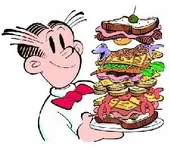
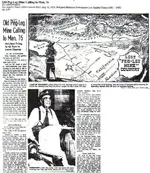
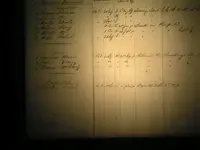
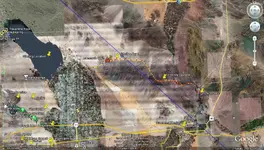
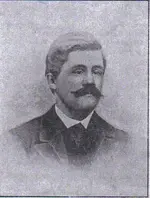
 Three words Carrizo Impact Area....Oh and a fourth word BOOM !!!! LOL... I would suspect that the gold " could " have been blown alll over the area ( this used to be a bombing range for pilots of WW2 ).
Three words Carrizo Impact Area....Oh and a fourth word BOOM !!!! LOL... I would suspect that the gold " could " have been blown alll over the area ( this used to be a bombing range for pilots of WW2 ). 
 ? You ALWAYS crack me up with them....LOL
? You ALWAYS crack me up with them....LOL? You ALWAYS crack me up with them....LOL



